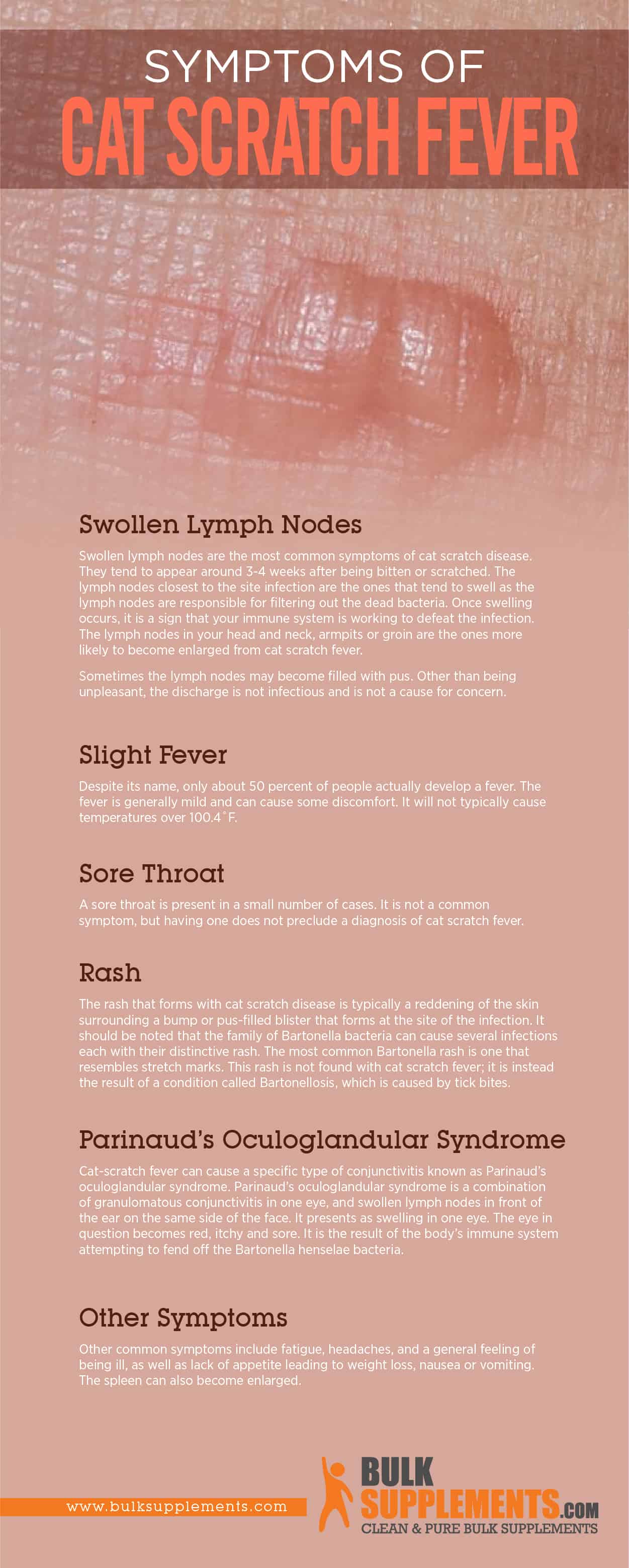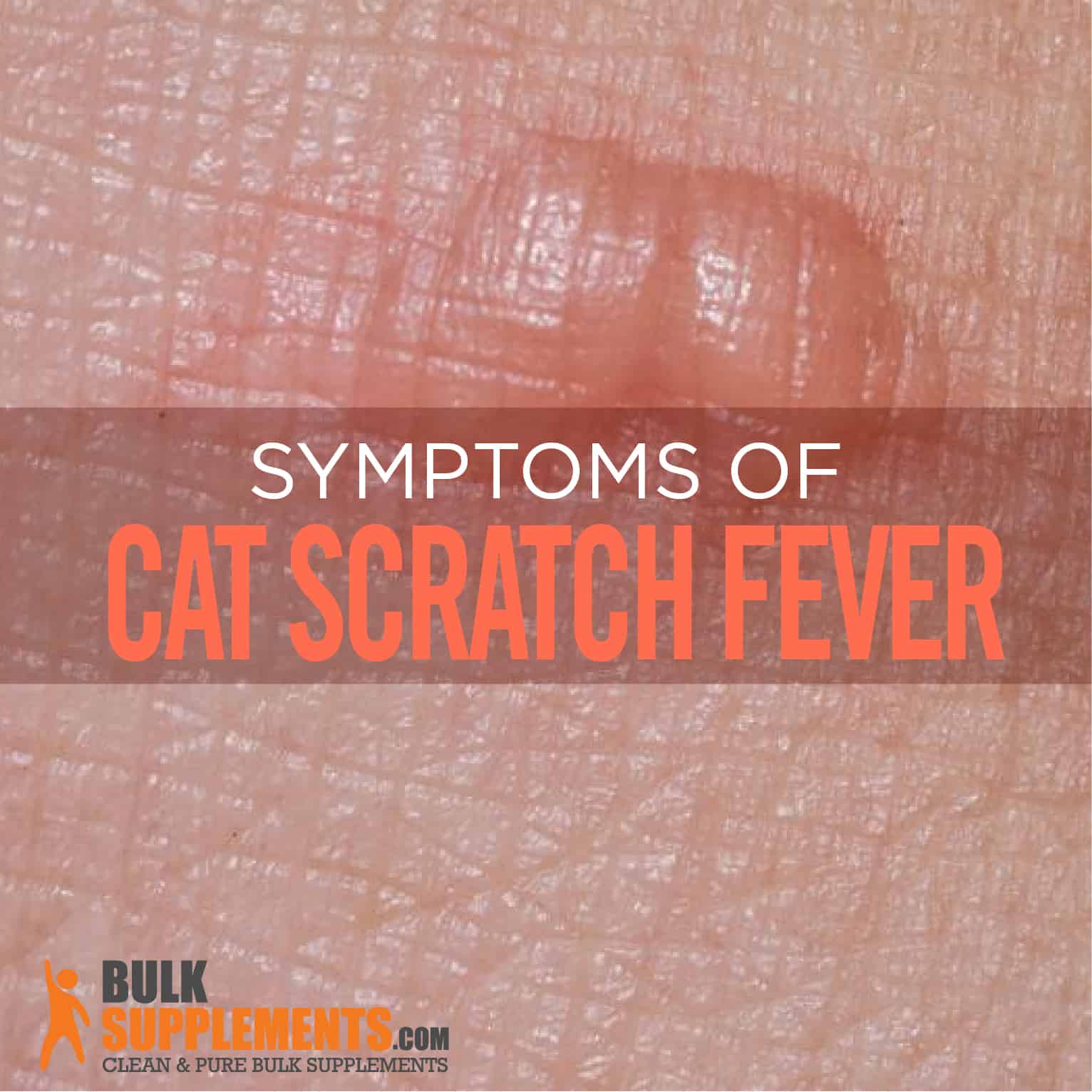What is Cat-Scratch Fever?
Cat scratch fever, also known as Bartonella infection or cat scratch disease (CSD), is a bacterial infection that results from a bite or a scratch from a cat. While the infectious disease is thought to be spread by the cat’s saliva, infected cats rarely show any symptoms. Around 40 percent of cats will carry the infection at some point in their lives, with young cats posing a higher risk than older cats. About 1 in 10,000 people are affected with cat-scratch disease (CSD), and it is most common in children.
How Does it Spread?
The bacteria responsible for the illness is called Bartonella henselae. It spreads to humans when the saliva from an infected cat enters an open wound. This happens in three main ways, namely scratches, bites and the licking of open wounds (x). Confirmation of the disease is possible through blood tests.
Three days to two weeks after being exposed to the bacteria, the site of the wound will begin to show signs of infection. Typical symptoms include non-painful bumps or blisters at the site of the infection and painful, swollen lymph nodes, which are warm to the touch. Other symptoms may include loss of appetite, fever and exhaustion. As the symptoms progress, the lymph nodes closest to the wound can also become swollen and painful (x).
Cat scratch disease is considered a non-serious condition, and if left untreated, it generally runs its course in six to 12 weeks (x). If you believe you have cat scratch fever, consult a doctor who may prescribe antibiotics to speed your recovery. If you are immunocompromised, the infectious disease can be more serious.
Avoiding Infection
The best ways to avoid developing cat scratch fever are to ensure you follow sensible hygiene procedures after playing with cats and kittens. Cover any open wounds. If you are scratched or bitten, make sure to disinfect the wound with soap and clean water (x).
If you own cats, you can further reduce the chances of becoming infected by following a flea prevention regimen. Fleas are the source of the Bartonella henselae bacteria in cats, so keeping on top of your cat’s flea treatments will help to reduce the risk of infection. It’s best to treat your pets every two months, to keep them fully protected from fleas.
Cat-Scratch Fever Symptoms
Swollen Lymph Nodes
Swollen lymph nodes are the most common symptoms of cat scratch disease (x). They tend to appear around 3-4 weeks after being bitten or scratched. The lymph nodes closest to the site of infection are the ones that tend to swell as the lymph nodes are responsible for filtering out the dead bacteria (x). Once swelling occurs, it is a sign that your immune system is working to defeat the infection. The lymph nodes in your head and neck, armpits or groin are the ones more likely to become enlarged from cat scratch fever (x).
Sometimes the lymph nodes may become filled with pus (x). Other than being unpleasant, the discharge is not infectious and is not a cause for concern.
Slight Fever
Despite its name, only about 50 percent of people actually develop a fever (x). The fever is generally mild and can cause some discomfort. It will not typically cause temperatures over 100.4˚F.
Sore Throat
A sore throat is present in a small number of cases. It is not a common symptom, but having one does not preclude a diagnosis of cat scratch fever.
Rash
The rash that forms with cat scratch disease is typically a reddening of the skin surrounding a bump or pus-filled blister that forms at the site of the infection. It should be noted that the family of Bartonella bacteria can cause several infections each with their distinctive rash (x). The most common Bartonella rash is one that resembles stretch marks. This rash is not found with cat scratch fever; it is instead the result of a condition called Bartonellosis, which is caused by tick bites (x).
Parinaud’s Oculoglandular Syndrome
Cat-scratch fever can cause a specific type of conjunctivitis known as Parinaud’s oculoglandular syndrome (x). Parinaud’s oculoglandular syndrome is a combination of granulomatous conjunctivitis in one eye, and swollen lymph nodes in front of the ear on the same side of the face. It presents as swelling in one eye. The eye in question becomes red, itchy and sore. It is the result of the body’s immune system attempting to fend off the Bartonella henselae bacteria.
Other Symptoms
Other common symptoms include fatigue, headaches, and a general feeling of being ill, as well as lack of appetite leading to weight loss, nausea or vomiting (x). The spleen can also become enlarged (x).
Causes of Cat-Scratch Fever
Bite or Scratch From Infected Cat
If you are bitten or scratched by an infected cat, and the wound breaks the skin, then there is a chance of being infected. In the case of a cat scratch or bite, clean and disinfect the wound, then bandage as necessary. Most cat bites and scratches can be painful but are ultimately not dangerous if proper treatment is followed.
Contacting Saliva of Infected Cat
Even if the infected cat does not scratch you, you could contract the disease if you have an open wound. If the cat licks the wound, it can pass the bacteria directly to you. To avoid this, it is best to bandage any open wounds before handling a cat and to wash your hands afterward.
Touching Eyes After Playing With Infected Cat
Parinaud’s oculoglandular syndrome may be caused by the transferal of bacteria (x). If you handle an infected cat and rub your eye without washing your hands this may directly transfer the bacteria into the lining of your eyes, leading to infection.

Cat-Scratch Fever Remedies and Supplements
As cat-scratch fever is a bacterial infection, you might assume that your doctor will automatically prescribe antibiotics. However, as there are more antibiotic-resistant bacteria in the world, doctors are hesitant to prescribe antibiotics when they are not needed (x). Cat-scratch fever is not life-threatening and has a limited life cycle, so does not necessarily need antibiotics.
Garlic
To give your immune system a real boost in its fight against the infection you could try adding a natural antibiotic to your diet. Garlic is an effective antibacterial agent against a range of bacteria, including Gram-negative ones like Bartonella henselae (x).
Unfortunately, the antibacterial effects of garlic are lost when cooked. So, to get the best impact, stick to raw garlic. If you are not a fan of chopping garlic or are not keen on the taste, try a garlic powder supplement. Adding a quarter teaspoon of garlic powder to a meal will dilute the flavor and provide you with all the natural benefits without the hassle of peeling and chopping garlic cloves.
Large amounts of garlic can cause gastrointestinal distress. Garlic has some anti-clotting properties, so avoid garlic if you are taking any anticoagulant drugs.
Coconut
Coconut is a surprisingly versatile food and has a range of health benefits including anti-inflammatory and antibacterial properties (x, x). However, coconut also contains high levels of fats and eating large amounts of coconut can have negative impacts on your weight and blood pressure.
Rather than eating a coconut a day in hopes of keeping the doctor away, you could opt for the more simple and healthier option of adding coconut powder to your diet. Adding one tablespoon to a drink will provide you with a healthy amount of coconut. Not only will it boost your immune system, it will also make your drink taste extra creamy.
You should not add coconut powder to your diet if you are pregnant or breastfeeding. If you are taking blood pressure medicine, speak to your doctor first.
Avoid Cats
If you are concerned about contracting cat-scratch disease, you can eliminate the risk by simply avoiding contact with cats. It is wise to avoid contact with stray or feral cats as they are more likely to be infected, as are young kittens. If you are immunocompromised but are keen to have a cat in your life, then it is best to adopt a cat that is older than a year, as kittens are more likely to bite and scratch (x,x).
Bacteria from this disease enters the body through open wounds, as well as the linings of your eyes. To keep yourself safe, stop cats from licking any open sores or around your eyes.
The Bottom Line
Cat-scratch fever is not a severe infection and typically runs its course between six and 12 weeks. The main symptoms are non-painful bumps or blisters at the site of the infection and painful, swollen lymph nodes, which are warm to the touch.
Cat-scratch fever is caused by contact with an infected cat. It can be prevented by using proper hygiene after handlings pet cats, avoiding contact with stray cats and by consistently using flea treatments on household cats.
If you believe you have the symptoms of cat-scratch fever and have been around cats in the last month, then you should consult a physician who can assess your condition and, if necessary, prescribe antibiotics. Some natural antibacterial foods you can supplement your diet with include garlic and coconut.


